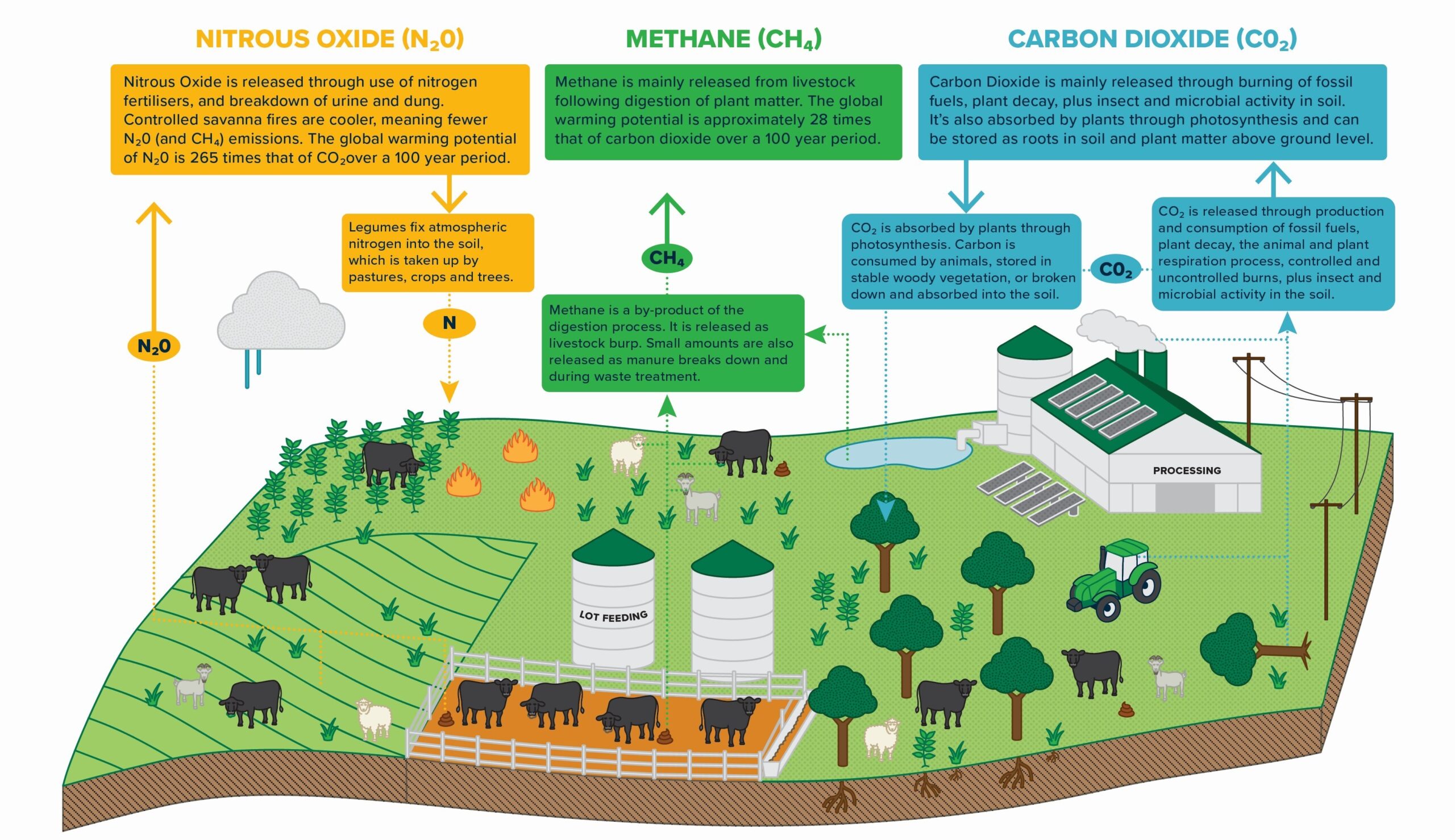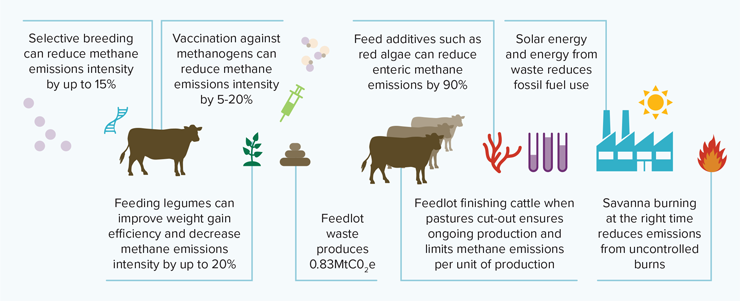Emissions from grazing systems
Written by Dr Hayley McMillan, Department of Agriculture and Fisheries (Queensland)

Australia’s red meat industry has reduced its greenhouse gas emissions by 59% since 2005 (from 133.4 Mt CO2e in 2005 to 54.6 Mt CO2e in 2015), primarily through reductions in land clearing (Mayberry 2022). As an industry, we are therefore on track to contribute to Australia’s 2030 Paris Climate Agreement (COP21) commitment of 43% below 2005 levels.
Here are four reasons we need to do more:
- Australia’s extreme weather conditions and expansive arid and semi-arid areas mean our agricultural systems are particularly susceptible to climate change
- Reducing the emissions intensity of red meat production (kg CO2e/kg red meat) can significantly improve production efficiency and business profitability (Figure 2, Eady et al., 2016).
- More than 65% of Australia’s 2021 red meat exports went to countries that have joined the Global Methane Pledge (GMP), which commits to a 30% reduction in methane emissions by 2030. The GMP was spearheaded by the United States (US) and the European Union (EU) which, to prevent an unfair disadvantage, have committed to taxing exports from countries that don’t take sufficient steps to reduce their carbon footprint. Australia has not joined the GMP, exports around 70% of agricultural output and ranks very low on the Climate Change Performance Index, making us vulnerable to carbon border adjustment policies if countries choose to include agricultural exports.
- Multinational agricultural supply chain companies have set their own targets, thereby signalling a trajectory for agricultural producers towards low emissions or carbon-neutral production (Eckard and Clark 2018; Eckard et al. 2022). For example: JBS has made a global commitment to achieve net zero emissions by 2040; NAB and Rabobank (who manage more than 50% of Australia’s agricultural debt) have committed to net zero financed emissions by 2050; and Coles has become the first major Australian supermarket to launch its own brand of carbon-neutral beef.

What is the primary source of emissions in my grazing system?
Methane (CH4) is the main greenhouse gas generated in ruminant grazing systems, typically contributing between 80% and 90% of total farm emissions (Figure 1) (Figure 3). Because methane is a powerful greenhouse gas and is short-lived compared to carbon dioxide, achieving significant reductions would have a rapid and significant effect on atmospheric warming potential. Figure 4 outlines options identified by the red meat industry to mitigate emissions from grazing systems.


How does the red meat industry plan to reach carbon neutrality?
The red meat industry’s pathway to carbon neutrality aligns with Australia’s definition of ‘carbon farming’: Management principles that minimise greenhouse gas emissions, maximise carbon sequestration in the landscape, while improving the productivity and resilience of agricultural systems.
What you can do now (MLA, 2022)
- Establish a short (5 to 10 years) and long-term (10 to 20 years) business plan.
- Arm yourself with knowledge. Identify your emission sources, know what carbon storage options are available and document these in your carbon account.
- Consider herd or flock management practices to improve livestock diet, breeding efficiency or structure to reduce methane emissions per kilogram of live weight produced.
- Consider energy efficiency or renewable energy technologies to reduce fossil fuel use which result in carbon dioxide emissions.
- Identify shade and shelter options on your property. Integrate trees and shrubs into grazing systems for improved carbon storage and animal health and biodiversity benefits. Your local
- Landcare group can help you choose the right tree and vegetation species for your region.
- Consider the potential for savanna fire management methods to avoid emissions and improve carbon storage.
- Monitor and record active dung beetle populations in your herd or flock and keep an eye out for new species as they are released.
Within three years (MLA, 2022)
- Establish deep‑rooted, palatable pastures and legumes to improve soil carbon levels and lift animal productivity.
- Plan for delivery and distribution of new feeds and supplements which reduce methane emissions from livestock and improve animal growth rates. This will enable more red meat to be produced for the same or reduced methane emissions.
- Assess progress toward your short and long-term business plans.
Have you got questions?
Sign up to the Carbon Neutral Grazier Network to receive quarterly emails with articles like this, invitations to exclusive webinars, access to industry leaders, and like-minded peers.
